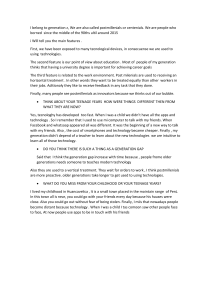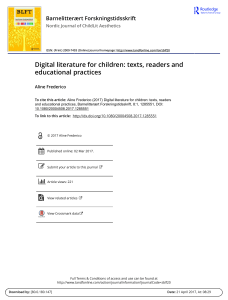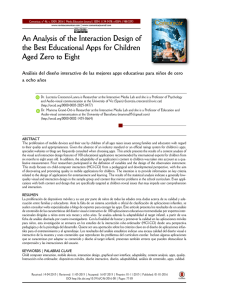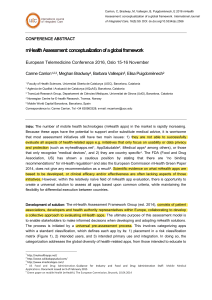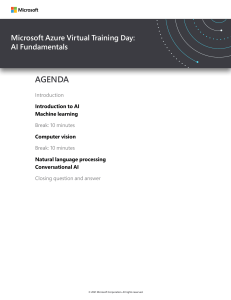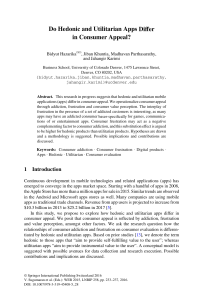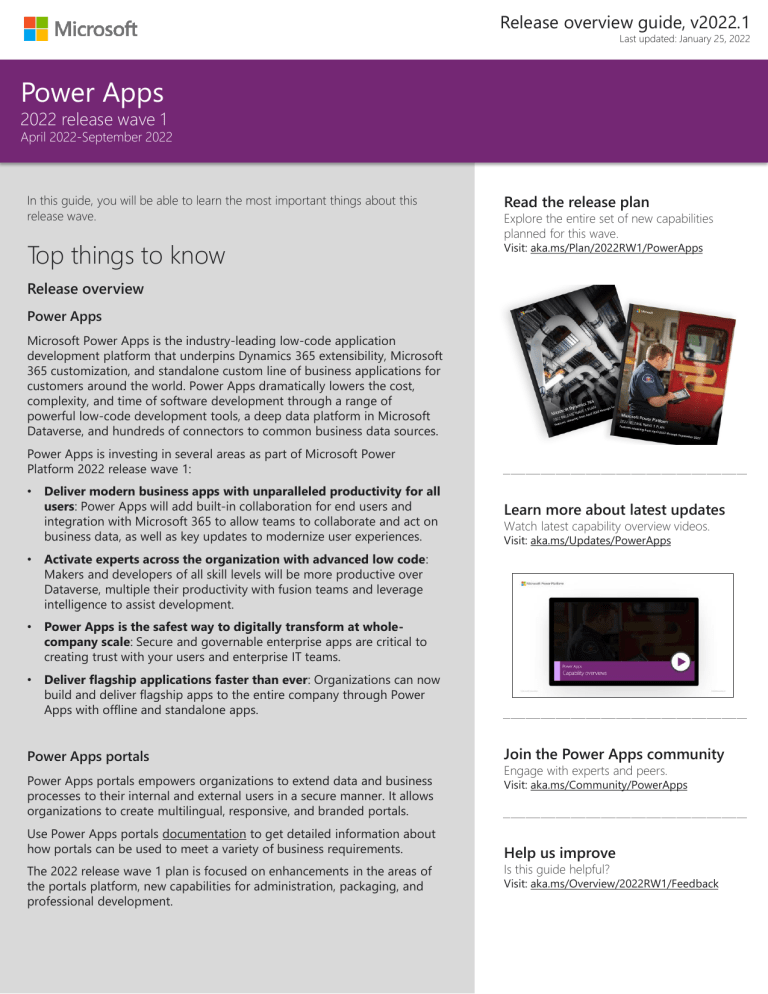
Release overview guide, v2022.1 Last updated: January 25, 2022 Power Apps 2022 release wave 1 April 2022-September 2022 In this guide, you will be able to learn the most important things about this release wave. Read the release plan Top things to know Visit: aka.ms/Plan/2022RW1/PowerApps Explore the entire set of new capabilities planned for this wave. Release overview Power Apps Microsoft Power Apps is the industry-leading low-code application development platform that underpins Dynamics 365 extensibility, Microsoft 365 customization, and standalone custom line of business applications for customers around the world. Power Apps dramatically lowers the cost, complexity, and time of software development through a range of powerful low-code development tools, a deep data platform in Microsoft Dataverse, and hundreds of connectors to common business data sources. Power Apps is investing in several areas as part of Microsoft Power Platform 2022 release wave 1: • Deliver modern business apps with unparalleled productivity for all users: Power Apps will add built-in collaboration for end users and integration with Microsoft 365 to allow teams to collaborate and act on business data, as well as key updates to modernize user experiences. • Activate experts across the organization with advanced low code: Makers and developers of all skill levels will be more productive over Dataverse, multiple their productivity with fusion teams and leverage intelligence to assist development. • Power Apps is the safest way to digitally transform at wholecompany scale: Secure and governable enterprise apps are critical to creating trust with your users and enterprise IT teams. • Deliver flagship applications faster than ever: Organizations can now build and deliver flagship apps to the entire company through Power Apps with offline and standalone apps. Learn more about latest updates Watch latest capability overview videos. Visit: aka.ms/Updates/PowerApps Power Apps portals Join the Power Apps community Power Apps portals empowers organizations to extend data and business processes to their internal and external users in a secure manner. It allows organizations to create multilingual, responsive, and branded portals. Visit: aka.ms/Community/PowerApps Use Power Apps portals documentation to get detailed information about how portals can be used to meet a variety of business requirements. The 2022 release wave 1 plan is focused on enhancements in the areas of the portals platform, new capabilities for administration, packaging, and professional development. Engage with experts and peers. Help us improve Is this guide helpful? Visit: aka.ms/Overview/2022RW1/Feedback Release overview guide, v2022.1 Last updated: January 25, 2022 Power Apps 2022 release wave 1 April 2022-September 2022 Overview Power Apps Microsoft Power Apps is the industry-leading low-code application development platform that underpins Dynamics 365 extensibility, Microsoft 365 customization, and standalone custom line of business applications for customers around the world. Power Apps dramatically lowers the cost, complexity, and time of software development through a range of powerful low-code development tools, a deep data platform in Microsoft Dataverse, and hundreds of connectors to common business data sources. Power Apps is investing in several areas as part of Microsoft Power Platform 2022 release wave 1: • Deliver modern business apps with unparalleled productivity for all users: Power Apps will add built-in collaboration for end users and integration with Microsoft 365 to allow teams to collaborate and act on business data, as well as key updates to modernize user experiences. • Activate experts across the organization with advanced low code: Makers and developers of all skill levels will be more productive over Dataverse, multiple their productivity with fusion teams and leverage intelligence to assist development. • Power Apps is the safest way to digitally transform at whole-company scale: Secure and governable enterprise apps are critical to creating trust with your users and enterprise IT teams. • Deliver flagship applications faster than ever: Organizations can now build and deliver flagship apps to the entire company through Power Apps with offline and standalone apps. For official product documentation and training for Power Apps, go to: • Power Apps docs • Power Apps training on Microsoft Learn Power Apps portals Power Apps portals empowers organizations to extend data and business processes to their internal and external users in a secure manner. It allows organizations to create multilingual, responsive, and branded portals. Use Power Apps portals documentation to get detailed information about how portals can be used to meet a variety of business requirements. The 2022 release wave 1 plan is focused on enhancements in the areas of the portals platform, new capabilities for administration, packaging, and professional development. Help us improve Is this guide helpful? Release overview guide, v2022.1 Last updated: January 25, 2022 Power Apps 2022 release wave 1 April 2022-September 2022 What’s new and planned Power Apps Rapid delivery of flagship applications Organizations can now build and deliver flagship apps to the entire company through Power Apps. Key updates include: • Accelerate line of business app dev professionals: Simplified development and management of offline apps. • Deliver standalone mission critical apps to every device: Create standalone, native mobile apps with Power Apps. Safest way to digitally transform at whole-company scale Secure and governable enterprise apps are critical to creating trust with your end users and enterprise IT teams. New capabilities are here to help you set the right policies to enable your enterprise apps across more places. Key updates include: • Solution quality and enforcement: Continuing to evolve the checkers already in place in Power Apps, these will evolve to be more comprehensive and enforce quality in production environments. • Security updates: Further updates on conditional access and providing more visibility to makers on security when sharing apps. Deliver modern business apps with unparalleled productivity for all users Users can take advantage of cohesive and modern experiences while collaborating with team members in Power Apps. Key updates include: • Apps built using Power Apps are now multiplayer with built-in collaboration: Enable users to collaborate, chat, and start meetings directly within the app. • Act on business data in context across Microsoft 365: See and act on Power Apps and Dynamics 365 data directly in Microsoft 365 by pasting a link. • Keep users on task with cohesive experiences and delightful UX: Modern and cohesive control updates across Power Apps provides a delightful and productive experience. Enable experts across the organization with advanced low code Makers and developers of all skill levels can be more productive with Power Apps and Dataverse, enabling fusion teams and leveraging intelligence to simplify common tasks. Key updates include: • It's easier than ever to get started with Dataverse: With simplified table creation and data load, the addition of Power Fx, and new modern low-code designers to simplify building apps over Dataverse. • Unleash fusion teams with collaborative development: Allow multiple makers to work on a single app at the same time, accelerating the time of development and supporting with Microsoft 365 style tools, such as commenting. • Infuse intelligence for makers and end users alike: Support developers to resolve common tasks and errors with intelligence. Help us improve Is this guide helpful? Release overview guide, v2022.1 Last updated: January 25, 2022 Power Apps 2022 release wave 1 April 2022-September 2022 Power Apps portals Professional developer experiences Power Apps portals provide support for professional tools and editors, such as the Power Platform CLI and Visual Studio Code. Professional developers can create, build, debug and publish their custom experiences quickly and efficiently. Professional developers can: • Use Power Platform CLI commands for portal to list, download, and upload portals. • Use deployment profiles to upload unique portal configurations to development, test, and production environments. • Use Power Platform CLI and GitHub Actions capabilities to enable CI/CD (Continuous Integration/Continuous Deployment) of portal configurations. • Use Visual Studio Code extension Power Platform Tools to improve productivity. Governance and administration Governance and administration features enable administrators to efficiently manage, configure, and maintain portals. These features allow administrators to: • View portal details, capacity consumption reports and update portal packages from the Power Platform Admin center. • Use self-service diagnostic tools such as the Portal Checker to identify and resolve common issues in portals. • Configure integration to other services (for example, SharePoint and Power BI), restrict access by IP address, enable maintenance mode, and other admin options. Core platform Portals core platform provides a rich set of out-of-the-box capabilities for makers to use as-is, configure, and customize in low-code/no-code ways and even build on top of using professional development techniques to meet business needs. Typical areas that describe the portals core platform are: • Content management system (CMS) capabilities to store web pages and related content • Data types and components, such as forms and lists that allow a user to interact with data in Dataverse using standard ways • User authentication by supporting oAuth 2.0, OpenID Connect, SAML 2.0, WS-Federation standard protocols • Security using a robust authorization model that provides granular control over permissions on portal pages and data in Dataverse tables • A configurable global search that allows searching content in Dataverse through portal pages • Extensibility options provided via code components, Web APIs, Liquid code, client-side scripts, custom style sheets, and web templates The additional and enhanced capabilities on the platform allow makers to enable more scenarios out-of-the-box while implementing Power Apps portals. Help us improve Is this guide helpful? Release overview guide, v2022.1 Last updated: January 25, 2022 Power Apps 2022 release wave 1 April 2022-September 2022 Portals configuration and packaging Portals content is stored as configuration within Dataverse tables. Use these enhancements for an improved experience in managing the application lifecycle of your portal across Dataverse environments. Typical areas that describe the portals configuration and packaging: • Package release which includes solution upgrades and data model changes. • Enhancement to Portal Management app. • Solution component framework for portals which enables ALM using solutions. Maker Studio Power Apps portals Studio and the Portal Management app are low-code/no-code tools that allow portal makers to configure Power Apps portals. To learn more about the entire set of capabilities being delivered during this release wave, check out the release plan for Power Apps below: Release Plan: aka.ms/Plan/2022RW1/PowerApps Help us improve Is this guide helpful? Release overview guide, v2022.1 Last updated: January 25, 2022 Power Apps 2022 release wave 1 April 2022-September 2022 For application administrators End-user impacting features to the user experience enabled automatically End-user impacting features should be reviewed by application administrators. This facilitates release change management and enables successful onboarding of new capabilities released to market. For the complete list, look for all features tagged “End users, automatically” in the release plan. Features that must be enabled by application administrators This release wave contains features that must be enabled or configured by administrators, makers, or business analysts to be available for their end users. For the complete list, look for all features tagged “End users by admins, makers, or analysts” in the release plan. Help us improve Is this guide helpful? Release overview guide, v2022.1 Last updated: January 25, 2022 Power Apps 2022 release wave 1 April 2022-September 2022 Get the most out of Power Apps Release plan View all capabilities included in this release. aka.ms/Plan/2022RW1/PowerApps Product updates Stay up to date on latest product updates. aka.ms/Updates/PowerApps Release calendar Know important release milestones. aka.ms/Updates/Calendar/PowerApps Licensing Improve your understanding of how to license Power Apps. aka.ms/Licensing/PowerApps Product documentation Find documentation for Power Apps. aka.ms/Documentation/PowerApps User community Engage with Power Apps experts and peers in the community. aka.ms/Community/PowerApps Upcoming events Find and register for in person and online events. aka.ms/Events/PowerApps Product trials Get started with Power Apps. © 2022 Microsoft Corporation. All rights reserved. This document is for informational purposes only. MICROSOFT MAKES NO WARRANTIES, EXPRESS, IMPLIED, OR STATUTORY, AS TO THE INFORMATION IN THIS DOCUMENT. Some examples are for illustration only and are fictitious. No real association is intended or inferred. aka.ms/Trials/PowerApps Help us improve Is this guide helpful?
